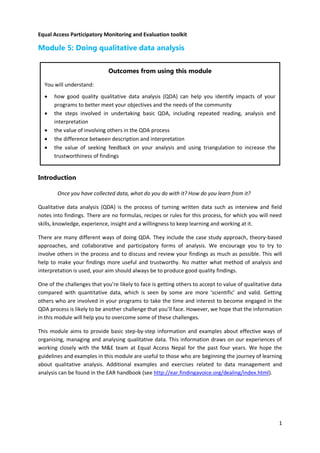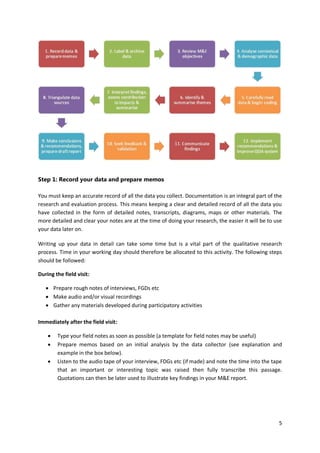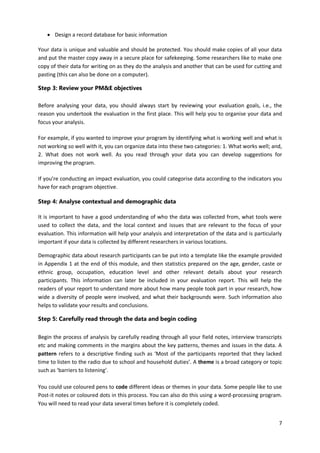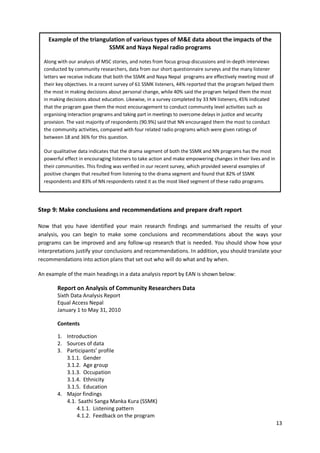The document provides a toolkit for conducting qualitative data analysis (QDA) to improve monitoring and evaluation in communication for development programs. It outlines the importance of QDA in understanding social change, engaging stakeholders, and enhancing program effectiveness, while also detailing steps for organizing, managing, and analyzing qualitative data. Additionally, it highlights challenges faced during the data collection process and emphasizes the need for systematic approaches and collaboration in achieving quality findings.










![11
Example of the interpretation of data about the impacts of the SSMK program
The data in the following example was collected using the MSC technique in four research sites in different
parts of Nepal. Interviews were conducted with four to six people in each site over a two month period. A
total of 19 stories were collected from 10 females and 5 males aged 16 - 19 and three women and one
man aged 35 - 45. Some details in the examples have been added to better illustrate the level of detail that
you should try to achieve in your reports.
Impact of SSMK
Improved Communication Skills
In five of the stories listening to SSMK encouraged four young people and one older woman to more
openly discuss important issues with members of their family and to communicate better with others, as
the following examples illustrate:
I started listening to the SSMK radio program and gaining knowledge from the drama segment. I made the
habit of open discussion with my daughters and started treating them as friends. My daughters were happy
with me and they even started helping me with work, and sharing their feelings and their school activities.
(Housewife, aged 49, Chhetri caste, Dadeldhura)
With the help of critical thinking [learned by listening to SSMK] I was able to communicate with my aunt.
Her husband works away from home and even she has to go to work during the morning. I put forward my
proposal - I told her that I shall look after her daughter till morning when she goes to work and once she is
back she will go to school. For that she should pay me for my school. She agreed and right now I am staying
at her home and my study is going fine. (Female student, aged 20, Dang)
Increased Motivation to Study
Six of the stories also showed that SSMK is helping some young people to increase their motivation to
study, as the following quotation demonstrates:
I am a regular listener of the SSMK program. I listen to the drama related to the importance of education. I
was affected by the drama that was aired about how a person who neglects his studies suffers in the later
phase of his life. This drama, as well as pressure from my mother and brother, helped me to realise the
importance of education. I find that I have an increased interest towards studies these days. Earlier, I used
to secure just-pass numbers in class 5, 6 and 7 but in class 8 I stood second. This is all due to the help of the
SSMK radio program and my family, that I have reached this place. (Male student, aged 17, Chhetri caste,
Dang)
Interpretation
The impacts mentioned above are part of our analysis of MSC stories which are regularly collected by
community researchers. They indicate that the SSMK program is effectively meeting its objectives of
building the life skills of young people and empowering young people to make good decisions. Our analysis
of these stories indicates that listening to SSMK has had a positive impact on some listeners in increasing
their skills in communication and critical thinking. These new skills, and the encouragement they have
gained from listening to the program, have helped to improve relationships among family members. Some
young people were also more motivated to study and later became more financially independent and
better able to contribute money to their household. As the quotations above indicate, the drama segment
of the program appears to have the most powerful effect in encouraging listeners to develop a more
positive attitude and to make empowering changes in their life. They also show that these impacts are
magnified by the encouragement of other family members who may not have listened to the program, but
have indirectly experienced some positive effects of the program such as improved communication and
relationships with their son or daughter.](https://image.slidesharecdn.com/eapmetoolkitmodule5qdaforpublication-160911031354/85/Doing-qualitative-data-analysis-11-320.jpg)







